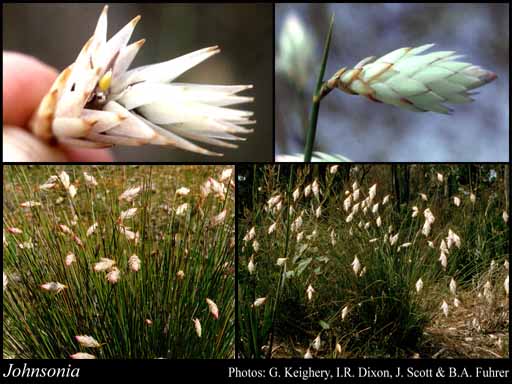- Reference
- Prodr.Fl.Nov.Holland. 287 (1810)
- Name Status
- Current

Scientific Description
Family Anthericaceae.
Sometimes included in Liliaceae.
Habit and leaf form. Herbs (tufted); evergreen, or deciduous. Switch-plants; with the principal photosynthesizing function transferred to stems (phyllocladodes looking like real leaves). Leaves well developed. Perennial. Leaves basal. Plants with a basal concentration of leaves, or with neither basal nor terminal concentrations of leaves; rhizomatous. Self supporting, or climbing. Mesophytic, or xerophytic. Leaves alternate; spiral, or distichous; ‘herbaceous’, or leathery, or membranous; sessile; sheathing. Leaf sheaths not tubular; with free margins. Leaves edgewise to the stem; simple. Leaf blades entire; flat; linear, or lanceolate, or oblong, or ovate; linear; parallel-veined; without cross-venules; sheathing. Leaves ligulate, or eligulate; without stipules. Leaf blade margins entire. Leaf anatomy. Hairs present, or absent. Extra-floral nectaries absent. Stem anatomy. Secondary thickening absent.
Reproductive type, pollination. Fertile flowers hermaphrodite. Unisexual flowers absent. Plants hermaphrodite. Floral nectaries present. Nectar secretion from the gynoecium (from septal nectaries).
Inflorescence and flower features. Flowers aggregated in ‘inflorescences’; in spikes. The terminal inflorescence unit cymose, or racemose (simple or compound). Inflorescences scapiflorous; terminal; inflorescence scape present or absent, simple, short to long, leafless; inflorescence several per plant, short or elongate, oblong; with involucral bracts (chartaceous, greenish or pinkish or red or white); pseudanthial, or not pseudanthial. Flowers pedicellate (shortly), or sessile; bracteate (inflorescence subtended by an awned erect leaf-like bract apparently continuous with the scape; floral bracts glume-like, large, imbricate, dry and concealing the flowers; lowest 1-several floral bracts empty); bracteolate (usually), or ebracteolate; small, or medium-sized; regular; 3 merous; cyclic; pentacyclic, or tetracyclic. Perigone tube present. Free hypanthium short, conspicuous. Perianth with distinct calyx and corolla (the whorls rather different), or of ‘tepals’; 6; 2 -whorled (3+3); isomerous; joined; petaloid; similar in the two whorls, or different in the two whorls; green, or white, or pink, or purple. Calyx (if the outer whorl so interpreted) 3; 1 -whorled; regular. Corolla (if the inner whorl so interpreted) 3; 1 -whorled; regular. Corolla members sometimes fringed. Androecial members definite in number. Androecium 3. Androecial members adnate; united with the gynoecium (loosely adhering to the style a little above insertion); all equal; coherent (all fused to each other); when joined, 1 - adelphous (basally connate); 1 -whorled, or 2 -whorled. Androecium exclusively of fertile stamens, or including staminodes. Staminodes when present, 3. Stamens 3; all more or less similar in shape; isomerous with the perianth, or diplostemonous; attached to the base of the inner segments at the top of the perianth tube; alterniperianthial, or oppositiperianthial. Anthers dorsifixed, or basifixed; dehiscing via longitudinal slits; introrse; tetrasporangiate. Gynoecium 3 carpelled. The pistil 3 celled. Carpels isomerous with the perianth. Gynoecium syncarpous; eu-syncarpous; superior. Ovary plurilocular; 3 locular; sessile. Gynoecium stylate. Styles 1; apical (or nearly so). Stigmas 1; 3 - lobed; capitate. Placentation axile. Ovules 2 per locule; arillate; campylotropous (generally), or anatropous.
Fruit and seed features. Fruit non-fleshy; dehiscent; usually a capsule. Capsules loculicidal. Fruit 3 celled; 3–6 seeded. Seeds endospermic; arillate. Cotyledons 1. Embryo straight to curved.
Additional characters Pollen grains trichotomosulcate.